[Hyogo Kobe] A thorough explanation of how to enjoy the sacred place of Japanese sake, “Nada Gogo”! We also introduce recommended sake bars!
![[Hyogo Kobe] A thorough explanation of how to enjoy the sacred place of Japanese sake, “Nada Gogo”! We also introduce recommended sake bars!](https://resources.matcha-jp.com/resize/720x2000/2023/12/22-159241.webp)
Nada Gogo is a famous sake-producing region that is famous nationwide as “Nada Sake.” We would like to introduce you to Nadagogosakedokoro, Kiku-Masamune Brewery Memorial Hall, and Taruzake Meister Factory located in Higashinada Ward, Kobe City. You can actually taste Nada's sake, one of Japan's most famous sakes, at a local sake brewery, and we will thoroughly introduce you to how this famous sake is made.
-
Table of Contents
- Nadagogo, the holy land of Japanese sake
- 1. Enjoy the pairing of sake and food! "Nadagogosakedokoro"
- 2. Approaching the charm of the long-established restaurant “Kiku-Masamune”
- 3. “Taru Sake Meister Factory” where you can see the craftsmanship right in front of your eyes
- [Official] Hyogo Prefecture tourism site HYOGO! navigation
Nadagogo, the holy land of Japanese sake
Nada Gogo, a famous sake-producing region known nationwide as “Nada Sake,” consists of five regions: Saigo, Mikagego, and Uozakigo in Kobe City, and Nishinomiyago and Imazugo in Nishinomiya City. A general term for sake brewing areas. We would like to introduce you to the valuable exhibits of the Kiku-Masamune Brewery Memorial Hall, a long-established sake brewery located in Uozaki-go, Higashinada-ku, Kobe City, as well as a tour of the craftsmen at work. In addition, we will introduce the secret behind the popularity of Nadagogosakedokoro Shop, a popular shop that has revolutionized the image of sake as ``old'' and ``formal'' and continues to create new sake fans, including young foreign visitors . We will thoroughly explain how to enjoy it.
1. Enjoy the pairing of sake and food! " Nadagogosakedokoro"
What kind of place is Nadagogosakedokoro?
![[Hyogo Kobe] A thorough explanation of how to enjoy the sacred place of Japanese sake, “Nada Gogo”! We also introduce recommended sake bars!](https://resources.matcha-jp.com/resize/720x2000/2023/12/21-158914.webp)
This is a standing bar in a former sake brewery where you can enjoy sake from Nadagogo's 26 breweries that go well with food based on the themes of ``seasonal,'' ``fermented,'' ``compatibility,'' and ``local.'' The store will open in April 2022 after renovating the Kenbishi Sake Brewery, which has a history of over 500 years. In a modern and stylish atmosphere that overturns the traditional image of an izakaya, Nada Gogo is spreading the new appeal of Japanese sake through events and other events.
Basic information Nadagogosakedokoro
Phone: 080-7945-8291
Business hours: Fridays, Saturdays, Sundays, and holidays 12:00-20:00 / Reservations accepted only on Mondays, Tuesdays, Wednesdays, and Thursdays (private reservations, events)
*Last order: Meal 20:00, Drinks 20:30 (Sundays and holidays: Meals 19:00, Drinks 19:30)
*If there are people waiting, we will have a 90-minute time limit (after 18:00, it will be relatively busy)
*Reservations are accepted online (24 hours) and by phone (during business hours only).
Access: 10 minutes walk from Hanshin "Mikage Station" Parking available nearby *Please refrain from driving if you are drinking alcohol.
![[Hyogo Kobe] A thorough explanation of how to enjoy the sacred place of Japanese sake, “Nada Gogo”! We also introduce recommended sake bars!](https://resources.matcha-jp.com/resize/720x2000/2023/12/21-158915.webp)
Food and drinks are ticketed. There are two types of tickets: 15 tickets for 3,000 yen and an additional 5 tickets for 1,000 yen. Tickets include tax and are valid for 6 months. If you purchase with cash, you can also get a refund for any remaining tickets.
![[Hyogo Kobe] A thorough explanation of how to enjoy the sacred place of Japanese sake, “Nada Gogo”! We also introduce recommended sake bars!](https://resources.matcha-jp.com/resize/720x2000/2023/12/21-158916.webp)
The dish is ``Sugitama Croquette'' made with fatty natural yellowtail purchased from the morning market, bread crumbs from a local bakery, and Kobe beef. As for the sake, we enjoyed the compatibility of ``Kenbishi Kuromatsu,'' which has a rich and mellow flavor, and ``Shiroka Special Sake,'' which has a rich flavor and sharpness.
![[Hyogo Kobe] A thorough explanation of how to enjoy the sacred place of Japanese sake, “Nada Gogo”! We also introduce recommended sake bars!](https://resources.matcha-jp.com/resize/720x2000/2023/12/21-158918.webp)
The most popular menu item is the Nadagogosakedokoro Set (15 tickets). The set includes 3 types of daily appetizers and 5 types of recommended sake from each of Nada Gogo (Saigo, Mikagego, Uozakigo, Nishinomiyago, and Imazugo). You will be given an explanation of the order in which you should enjoy the sake and food. We also recommend comparing drinks at different temperatures, such as cold sake, room temperature, lukewarm sake, and hot sake.
![[Hyogo Kobe] A thorough explanation of how to enjoy the sacred place of Japanese sake, “Nada Gogo”! We also introduce recommended sake bars!](https://resources.matcha-jp.com/resize/720x2000/2023/12/21-158919.webp)
There are many tourists from all over the country as well as foreign customers, and exchanges that transcend cultures and borders can be seen here and there. Various events were held, and the year-end countdown was said to be a great success.
2. Approaching the charm of the long-established restaurant “Kiku-Masamune”
Kiku-Masamune Sake Brewery Memorial Museum unravels the charm of Kiku-Masamune brewing
We will introduce the sake brewery memorial museum and ``Taru Kiku-Masamune Meister Factory'' of the long-established sake brewer ``Kiku Masamune'', which was founded in 1659 and has been producing sake in the Nada region for over 360 years. The museum, which exudes the dignity of a long-established sake brewery, is a sake brewery built in the main residence of the Kiku-Masamune family, the head of Kikumasamune in Mikage, and was moved to its current location in 1961.
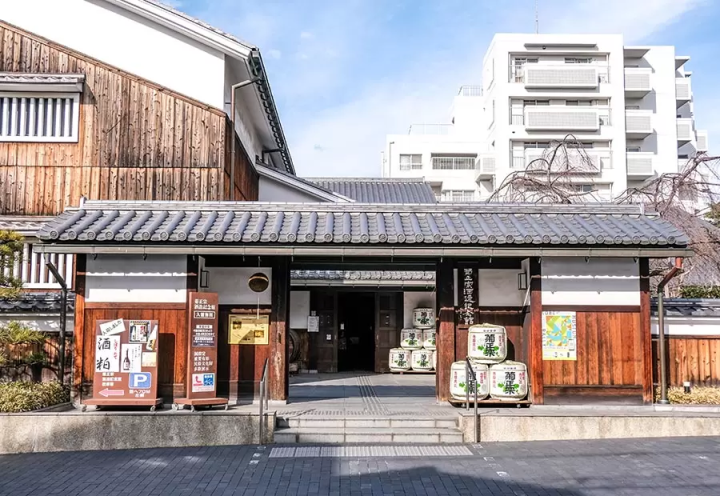
Although it suffered severe damage in the Great Hanshin-Awaji Earthquake, many of the exhibits miraculously survived, and it was reopened in 1999 after reconstruction. It vividly conveys the state of sake brewing that has been maintained since its founding.
Basic information Kiku-Masamune Sake Brewing Memorial Museum/Taruzake Meister Factory
TEL: 078-854-1029 FAX. 078-854-1028
Opening hours: 9:30-16:30 (Groups please make a reservation)
Closed: Year-end and New Year holidays (2023/12/30-2024/1/4)
Admission fee: Free *Some portions of sake are charged.
Access information By train
If using JR:
▪Get off at Sumiyoshi Station on the JR Kobe Line, then transfer to the Rokko Liner and get off at Minami-Uozaki Station (2nd station, approximately 4 minutes). 2 minutes walk northwest from the 1st floor of the elevator
If using Hanshin train:
▪Get off at Uozaki Station on the Hanshin Train. 10 minutes walk south along the Sumiyoshi River promenade "Clear stream path".
▪From the Osaka area [JR] Osaka Station - Sumiyoshi Station approximately 30 minutes / [Hanshin] Osaka Umeda Station - Uozaki Station approximately 35 minutes
▪From the Kobe area [JR] Sannomiya Station - Sumiyoshi Station approximately 8 minutes / [Hanshin] Kobe Sannomiya Station - Uozaki Station approximately 10 minutes
![[Hyogo Kobe] A thorough explanation of how to enjoy the sacred place of Japanese sake, “Nada Gogo”! We also introduce recommended sake bars!](https://resources.matcha-jp.com/resize/720x2000/2023/12/15-157068.webp)
In the entrance hall immediately after entering the Kiku-Masamune Sake Brewery Memorial Museum, there are exhibits and panels that will help you learn about ``Kiku-Masamune'' and other reasons why Nada Gogo became one of Japan's leading sake producers.
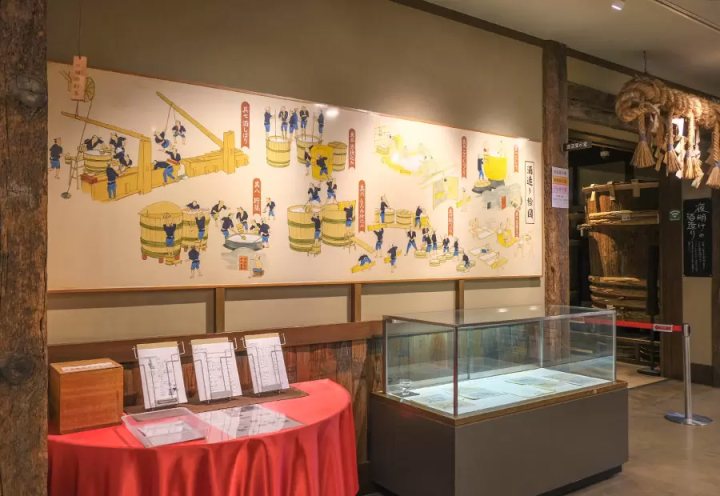
For example, we use Yamada Nishiki, a representative rice suitable for sake brewing. The main production areas are Misuku and Kato counties on the north side of Mt. Rokko, where high-quality sake is produced thanks to the favorable climate with a large temperature difference between day and night, rich clay soil, and the cooperation of farmers with advanced cultivation techniques. is being produced.
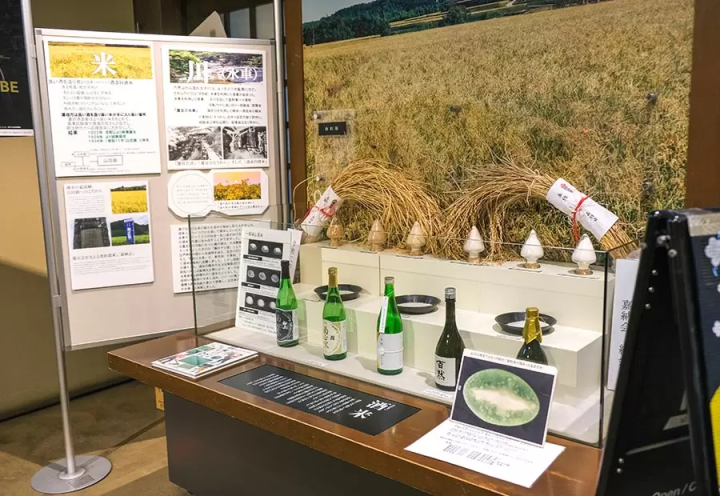
The hard water that gushes from the coast of Nishinomiya City is called ``Miyamizu'' and is essential for sake brewing in Nada. This water contains a lot of phosphorus and potassium, which make the yeast active.
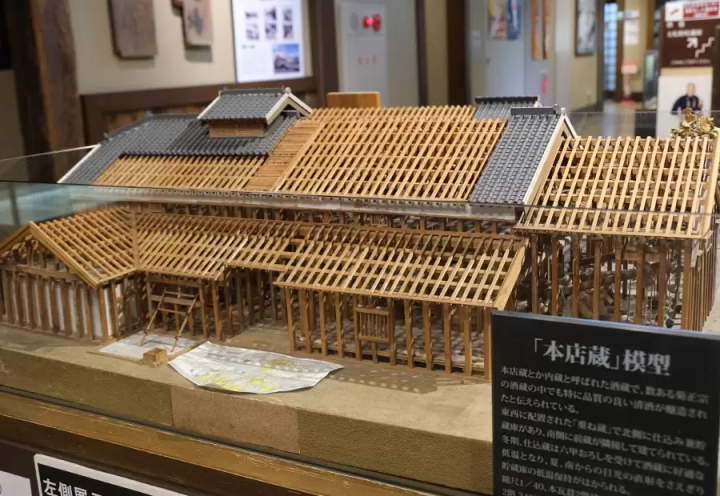
The sake brewery was easily exposed to the cold "Rokko Oroshi" wind that blows from Mt. Rokko, and the structure was designed to block sunlight from the south, creating an environment optimized for sake brewing.
![[Hyogo Kobe] A thorough explanation of how to enjoy the sacred place of Japanese sake, “Nada Gogo”! We also introduce recommended sake bars!](https://resources.matcha-jp.com/resize/720x2000/2023/12/14-156921.webp)
The ``Sake Brewing Exhibition Room'' displays many sake brewing tools from Nada, a ``Nationally Designated Important Tangible Folk Cultural Property'' that was actually used until the early Showa period, and introduces the sake brewing process in eight areas. The interior is dimly lit to evoke the atmosphere of 3 a.m. on a winter's day when sake brewing takes place, creating a sense of realism.
![[Hyogo Kobe] A thorough explanation of how to enjoy the sacred place of Japanese sake, “Nada Gogo”! We also introduce recommended sake bars!](https://resources.matcha-jp.com/resize/720x2000/2023/12/14-156922.webp)
Wash the polished white rice in the "washing area" by stepping on it. Just thinking about stepping on about 2 tons of rice a day with bare feet during the mid-winter preparation season makes me freeze.
![[Hyogo Kobe] A thorough explanation of how to enjoy the sacred place of Japanese sake, “Nada Gogo”! We also introduce recommended sake bars!](https://resources.matcha-jp.com/resize/720x2000/2023/12/14-156923.webp)
The rice is steamed in a ``kamaba'' and then sprinkled with koji mold spores in a ``koji room'' to allow the rice to propagate. This process converts the starch in the rice into glucose.
![[Hyogo Kobe] A thorough explanation of how to enjoy the sacred place of Japanese sake, “Nada Gogo”! We also introduce recommended sake bars!](https://resources.matcha-jp.com/resize/720x2000/2023/12/14-156924.webp)
At the motoba, rice malt, steamed rice, and water are placed in a vat and ground to create the base of sake, called shubo. ``Kiku-Masamune'' is particular about ``Kimoto making'' that utilizes the power of nature, and by passing down this technique from generation to generation, they are able to produce high-quality sake.
![[Hyogo Kobe] A thorough explanation of how to enjoy the sacred place of Japanese sake, “Nada Gogo”! We also introduce recommended sake bars!](https://resources.matcha-jp.com/resize/720x2000/2023/12/14-156925.webp)
At the brewery, rice koji, steamed rice, and water are added to the yeast mash in three stages for fermentation, a process known as three-stage preparation.The resulting mash is then aged at the funaba. I'll squeeze it. The finished sake is aged in large vats called ``kakoi-oke'' for six months to a year, and then sold as sake in early autumn.
![[Hyogo Kobe] A thorough explanation of how to enjoy the sacred place of Japanese sake, “Nada Gogo”! We also introduce recommended sake bars!](https://resources.matcha-jp.com/resize/720x2000/2023/12/14-156926.webp)
After enjoying the tour, head to the merchandise corner. Many sake made exclusively at the museum and original goods made with Kiku-Masamune are on sale. We also have a wide selection of snacks that can be enjoyed with alcohol.
![[Hyogo Kobe] A thorough explanation of how to enjoy the sacred place of Japanese sake, “Nada Gogo”! We also introduce recommended sake bars!](https://resources.matcha-jp.com/resize/720x2000/2023/12/14-156927.webp)
Be sure to check out the ``Kiku-Masamune'' corner, where you can sample sake made with ``Kiku Masamune'' for free. You can also choose your favorite sake from the ones provided and sample it for a fee.
3. “Taru Sake Meister Factory” where you can see the craftsmanship right in front of your eyes
What is “Taruzake” that has been passed down since the Edo period?
![[Hyogo Kobe] A thorough explanation of how to enjoy the sacred place of Japanese sake, “Nada Gogo”! We also introduce recommended sake bars!](https://resources.matcha-jp.com/resize/720x2000/2023/12/14-156929.webp)
After enjoying the Kiku-Masamune Brewery Memorial Museum, move on to the adjacent Taruzake Meister Factory across the road. This is a rare facility in Japan where you can see how barrels are made.
Taru-zake is a type of sake that is made by putting unprocessed sake into wooden barrels and flavoring it with wood aroma. When transporting sake during the Edo period, there were no bottles like there are today, so sake was packed into wooden sake barrels, resulting in barrel sake.
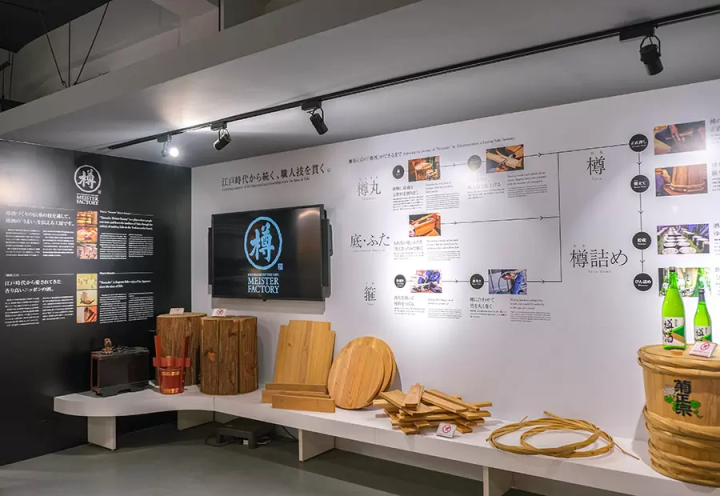
The barrels are made from carefully selected Yoshino cedar from the Yoshino region of Nara Prefecture. We only use carefully selected cedar trees that are over 100 years old and over 1m in diameter. After watching a 10-minute video at the lecture corner, you're ready to move on to the barrel-making workshop where the craftsmen are waiting.
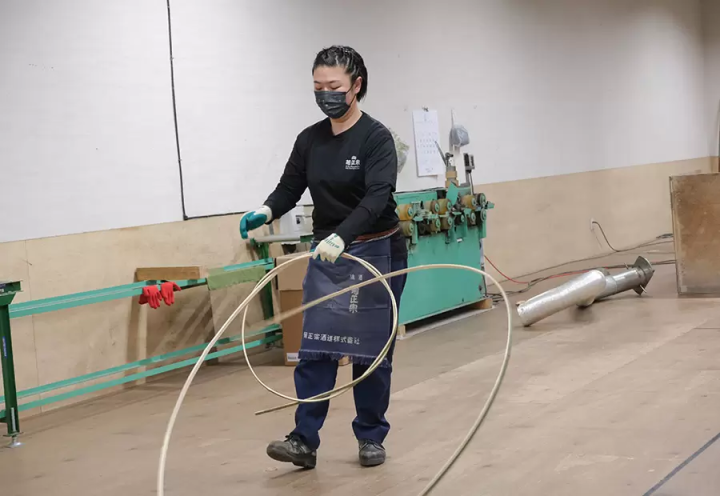
You can actually watch the craftsmen making barrels. First, we will make ``shijimaki'', which is made from the bamboo and taiga used to tighten the barrel. Bamboo, which is nearly 10 meters long, is split straight and then woven into a ring shape using the whole body.
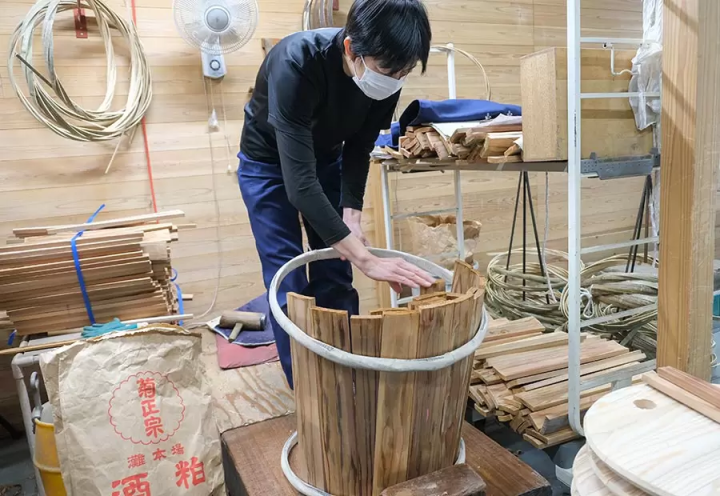
The Yoshino cedar used as the material is not the same size, and each piece has a slightly different shape even after being cut.
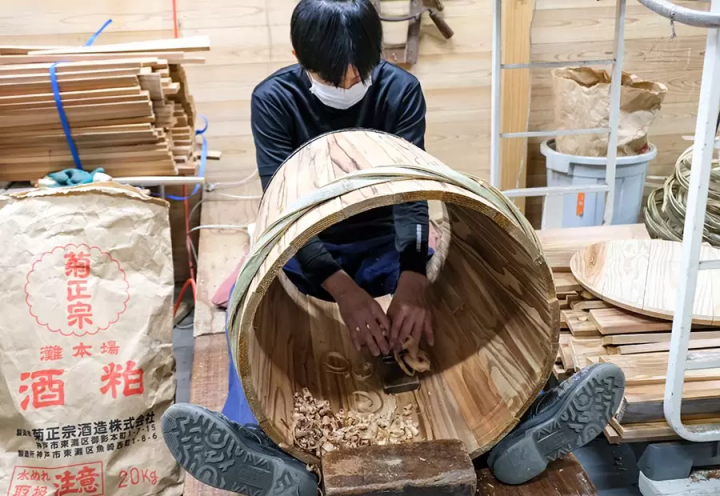
Craftsmen do almost all the steps with their bare hands, checking the humidity and texture of the wood and making small adjustments little by little.
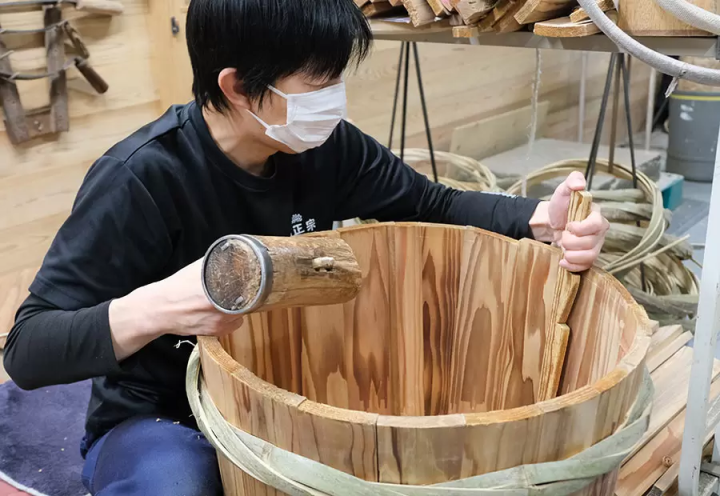
The tools used for assembly are handmade by craftsmen so that they fit comfortably in their hands.
![[Hyogo Kobe] A thorough explanation of how to enjoy the sacred place of Japanese sake, “Nada Gogo”! We also introduce recommended sake bars!](https://resources.matcha-jp.com/resize/720x2000/2023/12/14-156935.webp)
Being able to watch the cedar barrels being boldly assembled right in front of your eyes while carefully working to avoid any slight deviations is truly a miracle that can only be experienced at this workshop.
![[Hyogo Kobe] A thorough explanation of how to enjoy the sacred place of Japanese sake, “Nada Gogo”! We also introduce recommended sake bars!](https://resources.matcha-jp.com/resize/720x2000/2023/12/14-156936.webp)
The completed barrels are stored temporarily and filled with unprocessed sake according to orders. It is aged for several days and then bottled when it is at its most delicious. The finished barrel sake has a slight refreshing aroma of Yoshino cedar added to the unprocessed sake made using Kimoto-zukuri, allowing you to enjoy a refreshing and refreshing feeling while enjoying the relaxing richness.
[Official] Hyogo Prefecture tourism site HYOGO! navigation
The official website of Hyogo Tourism Headquarters, which provides tourist information for Hyogo Prefecture (Kobe, Himeji, Kinosaki, Awaji Island, etc.). There is a lot of recommended travel information, including special sightseeing spots such as Hyogo Prefecture's Japanese heritage sites and cycling, as well as model courses where you can enjoy hot spring culture and Japanese sake, so be sure to check it out!
Welcome to Hyogo Hyogo is a gateway to the Kansai region, which nurtures the blessed land that connects the Sea of Japan, the Chugoku Mountains, and the Seto Inland Sea, as well as the blessed climate. There are many spectacular views that will catch your eye, such as Himeji Castle, a World Heritage Site that was selected as one of the 100 Best Cherry Blossom Spots, and the panoramic night view from Mt. Rokko. The world-famous Kobe brand, KOBE BEEF, which is synonymous with Tajima beef, is one of Japan's leading beefs, and the sake rice ``Hyogo Yamada Nishiki'' is a gem that will surprise your tongue. Arima Onsen is a famous hot spring, and Kinosaki Onsen has appeared in many literary works. Surrounded by nature, you can relax your mind and body. You can come across memorable sounds such as the thunderous sounds of the whirlpools of Naruto on Awaji Island, and the dynamic sounds of the fireworks festivals held in various places in the summer. In the herb gardens and botanical gardens in the prefecture, you will be healed by the gentle and pleasant scent of herbs and flowers throughout the four seasons. Enjoy a new journey in Hyogo that stimulates the five senses of sight, taste, touch, hearing, and smell.
The contents on this page may partially contain automatic translation.
































![[2026] Top 5 Strawberry Picking Spots in Tokushima, Naruto| Farms and Access Guide for January to May](https://resources.matcha-jp.com/resize/720x2000/2025/03/06-227165.webp)


